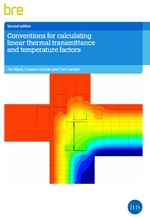Conventions for calculating linear thermal transmittance and temperature factors
BRE is an independent, research-based consultancy, testing and training organisation, operating in the built environment and associated industries.
On 3 June 2016, BRE published Conventions for calculating linear thermal transmittance and temperature factors (BR 497 2nd edition), written by Tim Ward, Graeme Hannah and Chris Sanders.
Well-insulated buildings require sophisticated techniques to model heat loss caused by thermal bridging at wall, roof and floor junctions and around openings. Thermal bridging at these junctions can add significantly to fabric heat loss and cause localised reduction in internal surface temperatures, which can lead to surface condensation and mould problems. A more detailed calculation method for U-values, as defined in BS EN ISO 6946:2007, has been introduced to take account of these repeating thermal bridges.
The BRE guide provides the information needed to carry out these calculations so that different users of the same software package or users of different software packages can obtain consistent and reproducible results. It is intended for use by designers and numerical modellers.
For building regulation purposes two key modelling outputs are identified:
These outputs enable designers to assess junction details and develop novel solutions to improve thermal performance.
The second edition of the guide has been updated to include additional junction types and information about how they should be modelled, as well as worked examples giving the determined values of linear thermal transmittance and temperature factors.
The contents of the guide are:
- Introduction.
- Numerical modelling.
- Thermal bridging at junctions.
- Junction types.
- Point thermal bridges, chi-values.
- Reporting of calculations.
- References.
- Appendix A: Detailed Input and Output from a numerical model.
- Appendix B: Worked examples with calculated values of psi and f.
[edit] Find out more
[edit] Related articles on Designing Buildings Wiki
- Air tightness in buildings.
- Cavity wall insulation.
- Computational fluid dynamics.
- Computational fluid dynamics in building design: An introduction FB 69.
- Conventions for U-value calculations (2006 edition) BR 443.
- Floor insulation.
- g-value.
- k-value.
- Heat transfer.
- Insulation specification.
- Limiting fabric parameters.
- Roof insulation.
- Solid wall insulation.
- Standard Assessment Procedure SAP.
- Thermal admittance.
- Thermal bridge.
- Thermal mass.
- Thermographic survey.
- U value.
- U-value conventions in practice: Worked examples using BR 443.
Featured articles and news
The UK’s largest air pollution campaign.
Future Homes Standard, now includes solar, but what else?
Will the new standard, due to in the Autumn, go far enough in terms of performance ?
BSRIA Briefing: Cleaner Air, Better tomorrow
A look back at issues relating to inside and outside air quality, discussed during the BSRIA briefing in 2023.
Restoring Abbotsford's hothouse
Bringing the writer Walter Scott's garden to life.
Reflections on the spending review with CIAT.
Retired firefighter cycles world to raise Grenfell funds
Leaving on 14 June 2025 Stephen will raise money for youth and schools through the Grenfell Foundation.
Key points for construction at a glance with industry reactions.
Functionality, visibility and sustainability
The simpler approach to specification.
Architects, architecture, buildings, and inspiration in film
The close ties between makers and the movies, with our long list of suggested viewing.
SELECT three-point plan for action issued to MSPs
Call for Scottish regulation, green skills and recognition of electrotechnical industry as part of a manifesto for Scottish Parliamentary elections.
UCEM becomes the University of the Built Environment
Major milestone in its 106-year history, follows recent merger with London School of Architecture (LSE).
Professional practical experience for Architects in training
The long process to transform the nature of education and professional practical experience in the Architecture profession following recent reports.
A people-first approach to retrofit
Moving away from the destructive paradigm of fabric-first.
International Electrician Day, 10 June 2025
Celebrating the role of electrical engineers from André-Marie Amperè, today and for the future.
New guide for clients launched at Houses of Parliament
'There has never been a more important time for clients to step up and ...ask the right questions'
The impact of recycled slate tiles
Innovation across the decades.
EPC changes for existing buildings
Changes and their context as the new RdSAP methodology comes into use from 15 June.

























